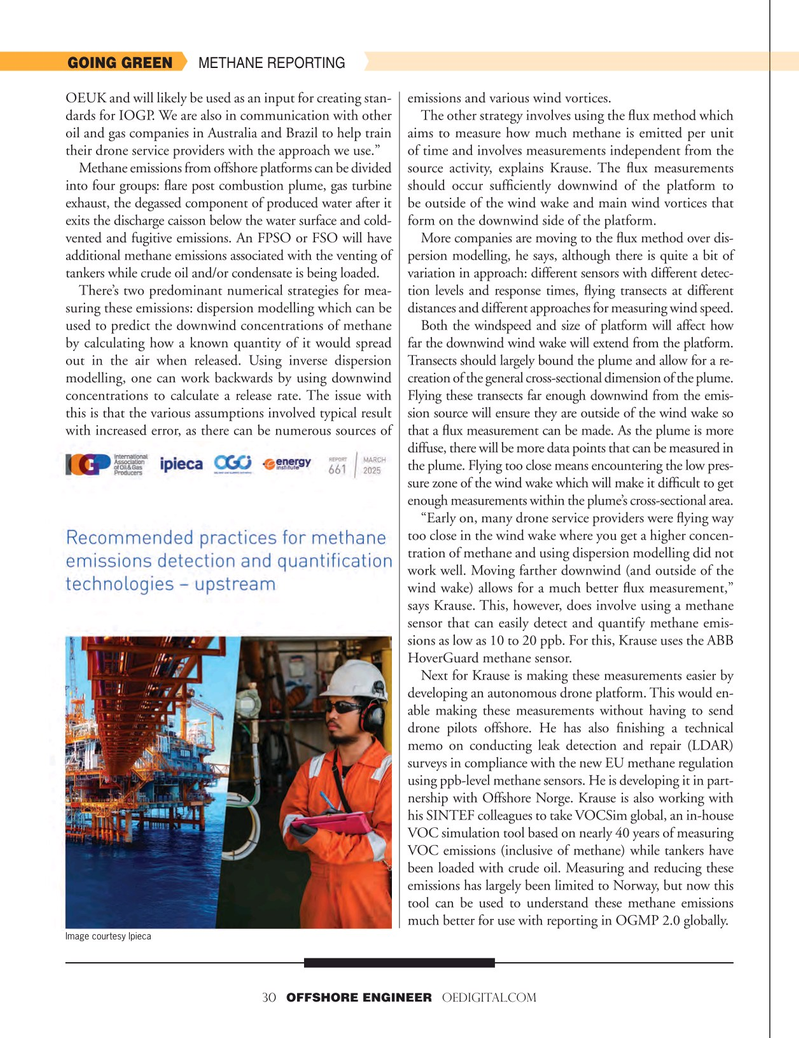
Page 30: of Offshore Engineer Magazine (May/Jun 2025)
Read this page in Pdf, Flash or Html5 edition of May/Jun 2025 Offshore Engineer Magazine
GOING GREEN METHANE REPORTING
OEUK and will likely be used as an input for creating stan- emissions and various wind vortices. dards for IOGP. We are also in communication with other The other strategy involves using the fux method which oil and gas companies in Australia and Brazil to help train aims to measure how much methane is emitted per unit their drone service providers with the approach we use.” of time and involves measurements independent from the
Methane emissions from offshore platforms can be divided source activity, explains Krause. The fux measurements into four groups: fare post combustion plume, gas turbine should occur suffciently downwind of the platform to exhaust, the degassed component of produced water after it be outside of the wind wake and main wind vortices that exits the discharge caisson below the water surface and cold- form on the downwind side of the platform.
vented and fugitive emissions. An FPSO or FSO will have More companies are moving to the fux method over dis- additional methane emissions associated with the venting of persion modelling, he says, although there is quite a bit of tankers while crude oil and/or condensate is being loaded. variation in approach: different sensors with different detec-
There’s two predominant numerical strategies for mea- tion levels and response times, fying transects at different suring these emissions: dispersion modelling which can be distances and different approaches for measuring wind speed.
used to predict the downwind concentrations of methane Both the windspeed and size of platform will affect how by calculating how a known quantity of it would spread far the downwind wind wake will extend from the platform. out in the air when released. Using inverse dispersion Transects should largely bound the plume and allow for a re- modelling, one can work backwards by using downwind creation of the general cross-sectional dimension of the plume. concentrations to calculate a release rate. The issue with Flying these transects far enough downwind from the emis- this is that the various assumptions involved typical result sion source will ensure they are outside of the wind wake so with increased error, as there can be numerous sources of that a fux measurement can be made. As the plume is more diffuse, there will be more data points that can be measured in the plume. Flying too close means encountering the low pres- sure zone of the wind wake which will make it diffcult to get enough measurements within the plume’s cross-sectional area.
“Early on, many drone service providers were fying way too close in the wind wake where you get a higher concen- tration of methane and using dispersion modelling did not work well. Moving farther downwind (and outside of the wind wake) allows for a much better fux measurement,” says Krause. This, however, does involve using a methane sensor that can easily detect and quantify methane emis- sions as low as 10 to 20 ppb. For this, Krause uses the ABB
HoverGuard methane sensor.
Next for Krause is making these measurements easier by developing an autonomous drone platform. This would en- able making these measurements without having to send drone pilots offshore. He has also fnishing a technical memo on conducting leak detection and repair (LDAR) surveys in compliance with the new EU methane regulation using ppb-level methane sensors. He is developing it in part- nership with Offshore Norge. Krause is also working with his SINTEF colleagues to take VOCSim global, an in-house
VOC simulation tool based on nearly 40 years of measuring
VOC emissions (inclusive of methane) while tankers have been loaded with crude oil. Measuring and reducing these emissions has largely been limited to Norway, but now this tool can be used to understand these methane emissions much better for use with reporting in OGMP 2.0 globally.
Image courtesy Ipieca 30 OFFSHORE ENGINEER OEDIGITAL.COM

 29
29

 31
31